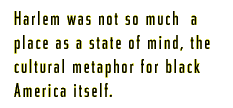"...what is needed is a reformulation of the Harlem Renaissance concept: a reconceptualization that, while retrospective, is also revisionist and resourceful, given the creative, mutable presence of the Harlem Renaissance ideal in assorted post-Harlem Renaissance cultural forms (literary and art criticism, exhibitions and contemporary cinema). For the purposes of this exercise the insertion of a virgule (/) into the word Re/Birth (or Re/Naissance) underscores this act of reconceptualization. By diacritically separating the prefix Re (which in Latin means 'back', 'again', 'anew' and 'over again') from the suffix Naissance (whose Latin root natus refers to 'birth', 'descent','beginning', 'dawn' and 'rise') we emphasize the concept's original sense of cultural and intellectual renewal and its visual agenda to rediscover and recreate a modern body (in this case a black one)."

Furthermore, by isolating Naissance and encouraging aspects of the Latin suffix natio to re-emerge (and, consequently, allude to 'tribe', 'race','people' and'class'),we invite interpretations of the Harlem Re/Naissancethat take into consideration the movement's often overlooked objective of establishing a new, spiritual, political, and self-conscious nation.
"....Harlem Re/Naissance is a provocative response to a new art era: an aesthetic retort that, like Jean Toomer's anthropomorphic, plum bearing perennial, transcends time to celebrate identity, creativity, the past, the present and the body politic. With the visual arts of the 1920s and 1930s anchored by black peoples, we can recollect and reimagine this twentieth century moment when Harlem was not only 'in vogue',or 'on the minds' of a complacent few, but also a geo-political metaphor for modernity and an icon for an increasingly complex black diasporal presence in the world."

"Since the earliest decades of this century the lure of Harlem has captivated the imagination of writers, artists, intellectuals and politicians around the world. Stories are legion of African-American pilgrims progressing to Manhattan then plunging into the ultimate symbolic black cultural space - the city within a city, the 'Mecca of the New Negro' (as Alain Locke put it in 1925) - that Harlem became in the first quarter of the twentieth century. Fidel Castro's recent pilgrimage uptown, recalling to mind his famous sojourn to the Hotel Teresa in 1960, is only the most recent of a long line of such pilgrimages into America's very own heart of darkness. The list of pilgrims is long and distinguished, and includes such varied notables as Max Weber and Carl Jung, Federico García Lorca and Octavio Paz, Zora Neale Hurston and Langston Hughes, Kwame Nkrumah and Wole Soyinka, Marcus Garvey and Malcolm X, Ezekiel Mphalele and Nelson Mandela. I could go on and on. 'Harlem was like a great magnet for the Negro intellectual,' Langston Hughes wrote, 'pulling him from everywhere. Once in New York, he had to live in Harlem.' Harlem was not so much a place as a state of mind, the cultural metaphor for black America itself."
"The first African-American renaissance took place at the turn of the century. Writing in 1901, the black Bostonian, William Stanley Braithwaite (a distinguished critic and poet), argued that 'We are at the commencement of a "negroid" renaissance...that will have as much importance in literary history as much spoken of and much praised Celtic and Canadian renaissance.' Writing at the end of a full decade of unprecedented literary production by black women (who published a dozen novels and edited their own literary journal between 1890 and 1900) and at a moment when the poet Paul Laurence Dunbar, the novelists Pauline Hopkins and Charles Chesnutt, and the essayists W.E.B. Du Bois and Anna Julia Cooper were at the height of their creative powers, a critic in the AME Church Review in 1904 declared the birth of 'The Negro Literary Movement', likening it, as had Braithwaite, to the Celtic renaissance."
Extracts from 'Re/Birth' of a Nation by Richard J. Powelland
'Harlem on Our Minds' by Henry Louis Gates Jr.
Rhapsodies in Black: Art of the Harlem Renaissance
(London/California: Hayward Gallery, Institute of International Visual
Arts and University of California Press, 1997).
Background image of 'Into Bondage' by Aaron Douglas, 1936
[Themes] - [Bibliography] - [Home] - [Credits]